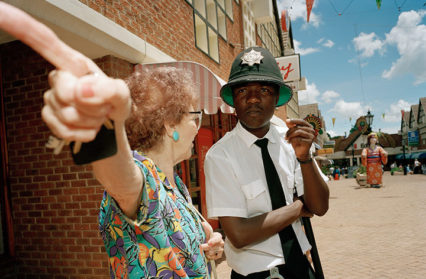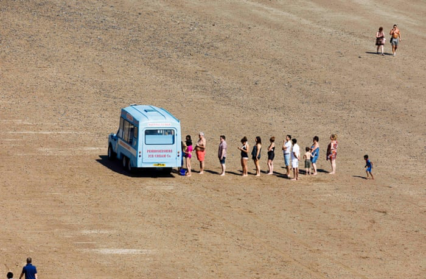Ben Woolhead takes in the major Martin Parr photography exhibition at the artist rooms at the National Museum in Cardiff.

‘This exhibition is not about Wales.’ On the face of it, an odd comment to make about an exhibition entitled Martin Parr in Wales, you might think, but in his foreword, to the accompanying book Owen Sheers goes on to explain: ‘What I mean by this, is that the images that make up its whole were not created in an attempt to capture the personality of the nation. They are not a concerted excavation of a specific communal identity.’ He’s right. The photographs have been taken at various intervals over the course of nearly half a century rather than for a single, pre-planned project; it is their selection and simultaneous display on the gallery walls that tempts the viewer into imagining otherwise.
Neither, one might add, are these pictures of Wales. The nation’s hills and coastlines have long been manna for photographers, but Parr has always been more interested in people’s perspectives, on and perceptions of their surroundings, than in the surroundings themselves. Tellingly, there is not a single ‘pure’ landscape image in the exhibition. There are, however, several in which the scenery is secondary to the human subjects’ responses to it; from one couple’s mild bafflement upon reaching Snowdon’s peak (via the mountain railway rather than on foot, judging by their attire) to the casual indifference of a woman who, while her partner takes pictures of the mountainous vista, remains sat in the car engrossed in her tabloid TV guide.
Parr’s work in general and projects like Small World, in particular, have taught us to be sensitive to point of view, and that our view of reality is always mediated through an assortment of prisms: windscreens, TV screens, advertisements. Not that Parr claims that his photographic mission is to capture naked reality. He’s too savvy to ignore his own positionality. As he recently told the Guardian’s Stephen Moss, ‘I just show things as I find them’, not, it should be noted, ‘as they really are’. ‘You could argue it’s fiction based on reality,’ he added; ‘my interpretation of the world.’ To the above list of mediating prisms, he would acknowledge, we must add camera lenses.
Indeed, Parr’s own perspective has previously come in for criticism, with some detecting a tone of middle-class condescension with regard to his subjects, most notably in the shots of seaside scenes that formed The Last Resort. However, this is, I think, rather unfair. His attitude would be better characterised as amused and (as the National Museum’s curators have it) ‘affectionate’. Certainly, such accusations could not be levelled at the generous, vibrant images taken in working men’s clubs that feature in the current exhibition.

Parr’s past detractors have included fellow photographer Philip Jones Griffiths, who vehemently objected to Parr’s membership of the prestigious Magnum agency on the grounds that there was no discernible moral purpose behind his work. To Jones Griffiths, who had forged his reputation in Vietnam, Parr’s subject matter seemed unforgivably trivial. Once again, though, Martin Parr in Wales undermines such a charge. Parr may not be on some kind of crusade, but his focus on leisure pursuits and consumer habits (illustrated particularly by the wall of garish images of food), on people at home and at play rather than at war, has a significant value of its own. In a nutshell, he is interested in using photography less as a means of effecting social change and more as a means of just recording it.
Sometimes, though, Parr’s objective seems to be no nobler than simply to raise a smile, whether through incongruity and juxtaposition (the well-dressed mourners on the beach; the glum black-faced miner sat in a tatty cafeteria surrounded by naff Christmas decorations), irony (the forlorn building bearing the sign ‘Funland’ at Aberafan’s derelict beach park in the mid-1980s) or just a neat image that speaks volumes (the Cardiff Council bin overflowing with the mangled skeletons of wind-wrecked umbrellas). It’s an objective that he regularly achieves with ease.
Some of the most recent seaside images, taken in Tenby with a telephoto lens, suggest a marked change of style as well as of technique. There is a greater distance between photographer and subject, both literally and metaphorically, to the extent that the figures Parr shoots are less rounded individuals and more abstract patterns arranged against flat beach backdrops. A sign, perhaps, that the celebrated people-watchers fascination with watching people is starting to wane? Hopefully not.
In an older picture, a market stallholder’s sign on a box of Jammie Dodgers reads ‘Just out of date but 100% perfect’. The just-out-of-date images in Martin Parr in Wales might not be quite 100 per cent perfect, but they’re not far off.
An exhibition of Martin Parr Photography will be on display at the National Museum of Wales until 4th May 2020. Entry is free!
Ben Woolhead is a regular contributor to Wales Arts Review.












